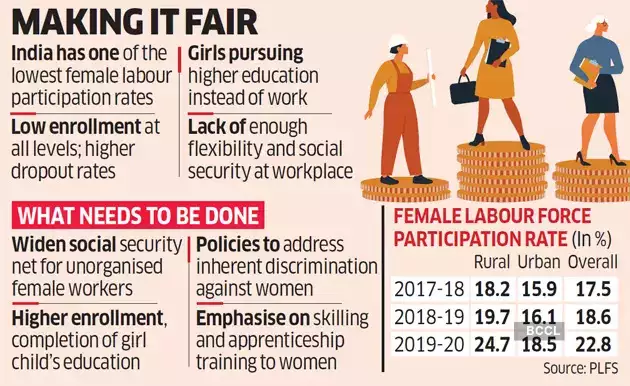Ahmedabad
(Head Office)Address : 506, 3rd EYE THREE (III), Opp. Induben Khakhrawala, Girish Cold Drink Cross Road, CG Road, Navrangpura, Ahmedabad, 380009.
Mobile : 8469231587 / 9586028957
Telephone : 079-40098991
E-mail: dics.upsc@gmail.com

News: Last month, India surpassed China as the world's most populous country, prompting analysts to point out the potential benefits of its significant young demographic. However, a major obstacle to realising this potential is the insufficient representation of women in India's workforce.
→ According to data from the World Bank, the female participation rate in India's labour force was at its peak in 2000 at 31%. Since then, it has consistently fallen, hitting a low of 21% in 2018.
→ A 2018 McKinsey report estimated that India could add $550bn to its gross domestic product by increasing its female labour force participation by just 10%.
→ Currently, women employees account for less than 20% of India's manufacturing sector.
→ India is still a largely patriarchal society, where women are expected to be primary caregivers at home.
→ Indian women spend eight times the number of hours on unpaid care work compared with men, according to a national time use survey from 2019. The global average is three times.
→ Experts say that safety concerns and not being able to find jobs close to home also prevent women in big cities from joining the workforce.
→ Lack of opportunities for women returning to their careers after a professional break.
→ Concentration in low/non-productive jobs: Like agriculture, primary caregiver at home, etc.
→ Gender inequality – Almost 19% of employed women had regular salaried jobs while compared to 60% of employed men had regular salaried jobs. (Oxfam India Report)
→ The Maternity Benefit (Amendment) Act 2017 provides for enhancement in paid maternity leave from 12 weeks to 26 weeks and provisions for mandatory crèche facilities.
→ An advisory is provided to the States under the Factories Act 1948 for permitting women workers in the night shifts with adequate safety measures.
→ A number of protective provisions have been incorporated in various labour laws – The Equal Remuneration Act 1976, The Minimum Wages Act 1948.
→ A network of Women Industrial Training institutes, National Vocational Training Institutes and Regional Vocational Training Institutes.
→ Gabriel India Ltd - an auto parts company in Hosur - says that more than 20% of the workers in its factories are women.
→ The company provides perks such as on-site accommodation, subsidised food and several training programmes to attract more women workers.
→ They believe that attrition rates for women are lower.
→ A policy framework encouraging and enabling women’s participation should be constructed.
→ Active awareness of the “gender-specific” constraints that face most women.
→ Gender-responsive policies need to be developed.
Source – BBC, Oxfam India Report

Address : 506, 3rd EYE THREE (III), Opp. Induben Khakhrawala, Girish Cold Drink Cross Road, CG Road, Navrangpura, Ahmedabad, 380009.
Mobile : 8469231587 / 9586028957
Telephone : 079-40098991
E-mail: dics.upsc@gmail.com
Address: A-306, The Landmark, Urjanagar-1, Opp. Spicy Street, Kudasan – Por Road, Kudasan, Gandhinagar – 382421
Mobile : 9723832444 / 9723932444
E-mail: dics.gnagar@gmail.com
Address: 2nd Floor, 9 Shivali Society, L&T Circle, opp. Ratri Bazar, Karelibaugh, Vadodara, 390018
Mobile : 9725692037 / 9725692054
E-mail: dics.vadodara@gmail.com
Address: 403, Raj Victoria, Opp. Pal Walkway, Near Galaxy Circle, Pal, Surat-394510
Mobile : 8401031583 / 8401031587
E-mail: dics.surat@gmail.com
Address: 303,305 K 158 Complex Above Magson, Sindhubhavan Road Ahmedabad-380059
Mobile : 9974751177 / 8469231587
E-mail: dicssbr@gmail.com
Address: 57/17, 2nd Floor, Old Rajinder Nagar Market, Bada Bazaar Marg, Delhi-60
Mobile : 9104830862 / 9104830865
E-mail: dics.newdelhi@gmail.com